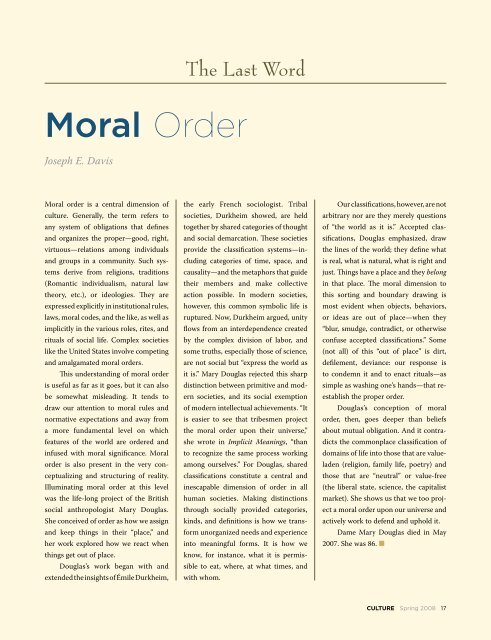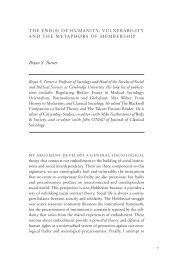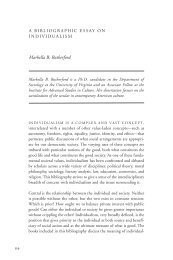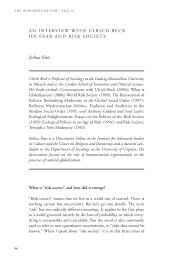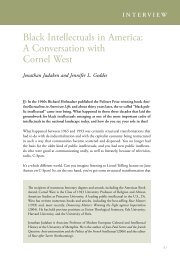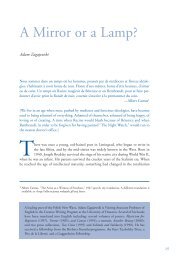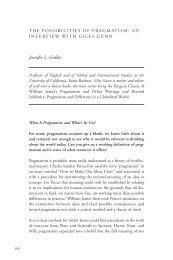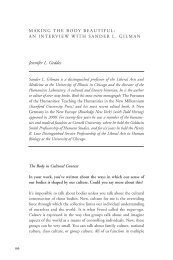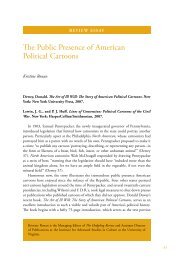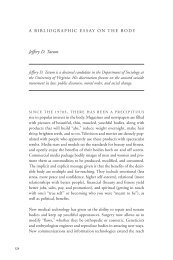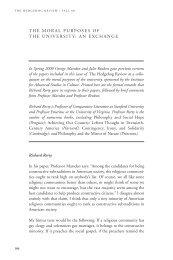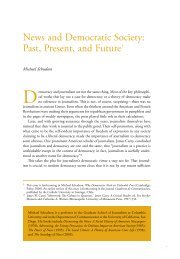ambiguous distinctions - Institute for Advanced Studies in Culture
ambiguous distinctions - Institute for Advanced Studies in Culture
ambiguous distinctions - Institute for Advanced Studies in Culture
You also want an ePaper? Increase the reach of your titles
YUMPU automatically turns print PDFs into web optimized ePapers that Google loves.
The Last Word<br />
<br />
Joseph E. Davis<br />
Moral order is a central dimension of<br />
culture. Generally, the term refers to<br />
any system of obligations that def<strong>in</strong>es<br />
and organizes the proper—good, right,<br />
virtuous—relations among <strong>in</strong>dividuals<br />
and groups <strong>in</strong> a community. Such systems<br />
derive from religions, traditions<br />
(Romantic <strong>in</strong>dividualism, natural law<br />
theory, etc.), or ideologies. They are<br />
expressed explicitly <strong>in</strong> <strong>in</strong>stitutional rules,<br />
laws, moral codes, and the like, as well as<br />
implicitly <strong>in</strong> the various roles, rites, and<br />
rituals of social life. Complex societies<br />
like the United States <strong>in</strong>volve compet<strong>in</strong>g<br />
and amalgamated moral orders.<br />
This understand<strong>in</strong>g of moral order<br />
is useful as far as it goes, but it can also<br />
be somewhat mislead<strong>in</strong>g. It tends to<br />
draw our attention to moral rules and<br />
normative expectations and away from<br />
a more fundamental level on which<br />
features of the world are ordered and<br />
<strong>in</strong>fused with moral significance. Moral<br />
order is also present <strong>in</strong> the very conceptualiz<strong>in</strong>g<br />
and structur<strong>in</strong>g of reality.<br />
Illum<strong>in</strong>at<strong>in</strong>g moral order at this level<br />
was the life-long project of the British<br />
social anthropologist Mary Douglas.<br />
She conceived of order as how we assign<br />
and keep th<strong>in</strong>gs <strong>in</strong> their “place,” and<br />
her work explored how we react when<br />
th<strong>in</strong>gs get out of place.<br />
Douglas’s work began with and<br />
extended the <strong>in</strong>sights of Émile Durkheim,<br />
the early French sociologist. Tribal<br />
societies, Durkheim showed, are held<br />
together by shared categories of thought<br />
and social demarcation. These societies<br />
provide the classification systems—<strong>in</strong>clud<strong>in</strong>g<br />
categories of time, space, and<br />
causality—and the metaphors that guide<br />
their members and make collective<br />
action possible. In modern societies,<br />
however, this common symbolic life is<br />
ruptured. Now, Durkheim argued, unity<br />
flows from an <strong>in</strong>terdependence created<br />
by the complex division of labor, and<br />
some truths, especially those of science,<br />
are not social but “express the world as<br />
it is.” Mary Douglas rejected this sharp<br />
dist<strong>in</strong>ction between primitive and modern<br />
societies, and its social exemption<br />
of modern <strong>in</strong>tellectual achievements. “It<br />
is easier to see that tribesmen project<br />
the moral order upon their universe,”<br />
she wrote <strong>in</strong> Implicit Mean<strong>in</strong>gs, “than<br />
to recognize the same process work<strong>in</strong>g<br />
among ourselves.” For Douglas, shared<br />
classifications constitute a central and<br />
<strong>in</strong>escapable dimension of order <strong>in</strong> all<br />
human societies. Mak<strong>in</strong>g <strong>dist<strong>in</strong>ctions</strong><br />
through socially provided categories,<br />
k<strong>in</strong>ds, and def<strong>in</strong>itions is how we trans<strong>for</strong>m<br />
unorganized needs and experience<br />
<strong>in</strong>to mean<strong>in</strong>gful <strong>for</strong>ms. It is how we<br />
know, <strong>for</strong> <strong>in</strong>stance, what it is permissible<br />
to eat, where, at what times, and<br />
with whom.<br />
Our classifications, however, are not<br />
arbitrary nor are they merely questions<br />
of “the world as it is.” Accepted classifications,<br />
Douglas emphasized, draw<br />
the l<strong>in</strong>es of the world; they def<strong>in</strong>e what<br />
is real, what is natural, what is right and<br />
just. Th<strong>in</strong>gs have a place and they belong<br />
<strong>in</strong> that place. The moral dimension to<br />
this sort<strong>in</strong>g and boundary draw<strong>in</strong>g is<br />
most evident when objects, behaviors,<br />
or ideas are out of place—when they<br />
“blur, smudge, contradict, or otherwise<br />
confuse accepted classifications.” Some<br />
(not all) of this “out of place” is dirt,<br />
defilement, deviance: our response is<br />
to condemn it and to enact rituals—as<br />
simple as wash<strong>in</strong>g one’s hands—that reestablish<br />
the proper order.<br />
Douglas’s conception of moral<br />
order, then, goes deeper than beliefs<br />
about mutual obligation. And it contradicts<br />
the commonplace classification of<br />
doma<strong>in</strong>s of life <strong>in</strong>to those that are valueladen<br />
(religion, family life, poetry) and<br />
those that are “neutral” or value-free<br />
(the liberal state, science, the capitalist<br />
market). She shows us that we too project<br />
a moral order upon our universe and<br />
actively work to defend and uphold it.<br />
Dame Mary Douglas died <strong>in</strong> May<br />
2007. She was 86.


